Investigating the Impact of Energy Source Level on the Self-Guided Vehicle System Performances, in the Industry 4.0 Context
Abstract
1. Introduction
2. Context
3. State-of-the-Art
3.1. Path Planning
- Cell decomposition approximation: is a basic approximation that consists of representing the grid with uniform fixed size cell (Figure 6a). The graph search algorithm presented in Section (III-C) will explore all the C-free cells to find a feasible path. The lesser the size of the cell the more precise the map building will be. However, the larger the grid the more complex the calculation will be. Some alternative cell decomposition methods to remedy this drawback exist.
- Adaptive cell decomposition: the adaptive cell decomposition method is used to relief the computation effort of the search by focusing on an area near to the obstacles (Figure 6b). This method starts by representing the grid with a larger cell size. Using Quad-tree (2D square cell) or octree (3D cubic cell) recursive method that splits every partially occupied cell into, respectively, four or eight equal subcells, until either every cell of the grid is completely occupied or in a free space, or minimum cell size is attained.
- Exact cell decomposition: is based on the polygonal shape representation of obstacles on the map (Figure 6c). The planning space is represented with trapezoidal or vertical cells that are defined by the obstacle edges. The path is then created through adjacent C-free cells.
3.2. Optimality-Based Planning
3.2.1. Sampling-Based Planning
3.2.2. Search-Based Planning
3.2.3. Waypoint-Based Planning
3.3. Graph Search Algorithms
3.3.1. Heuristic-Based Search Algorithm
3.3.2. Incremental Replanning Algorithm
3.4. Planning Global Trajectory in the Context of Industry 4.0: An Overview
4. Investigating Energy Influence on the Navigation Performances
5. Investigation Method
5.1. Experimental Setup
5.2. Scenario
5.3. Results & Discussions
6. Conclusions
- Considering that when allocating tasks to the SGV, the vehicle has to seek for paths, evaluate a multi-objective cost function and, based on the resource state, report in real-time whether it is able to execute the task or not.
- Adapting the generated global trajectories based on the link between the fleet of SGVs and resource management.
Author Contributions
Funding
Acknowledgments
Conflicts of Interest
References
- Flämig, H. Autonomous vehicles and autonomous driving in freight transport. In Autonomous Driving; Springer: Berlin, Germany, 2016; pp. 365–385. [Google Scholar]
- Li, P.; Liu, X. Common Sensors in Industrial Robots: A Review; Journal of Physics: Conference Series; IOP Publishing: Bristol, UK, 2019. [Google Scholar]
- Devy, M.; Chatila, R.; Fillatreau, P.; Lacroix, S.; Nashashibi, F. On autonomous navigation in a natural environment. Robot. Auton. Syst. 1995, 16, 5–16. [Google Scholar] [CrossRef]
- Zhong, R.Y.; Xu, X.; Klotz, E.; Newman, S. Intelligent manufacturing in the context of industry 4.0: A review. Engineering 2017, 3, 616–630. [Google Scholar] [CrossRef]
- Efthymiou, O.Κ.; Ponis, S.T. Current Status of Industry 4.0 in Material Handling Automation and In-house Logistics. Int. J. Ind. Manuf. Eng. 2019, 13, 1370–1374. [Google Scholar]
- Apostolos, F.; Alexios, P.; Georgios, P.; Panagiotis, S.; George, C. Energy efficiency of manufacturing processes: A critical review. Procedia CIRP 2013, 7, 628–633. [Google Scholar] [CrossRef]
- Bonilla, S.H.; Silva, H.R.O.; da Silva, M.T.; Gonçalves, R.F.; Sacomano, J.B. Industry 4.0 and sustainability implications: A scenario-based analysis of the impacts and challenges. Sustainability 2018, 10, 3740. [Google Scholar] [CrossRef]
- Shrouf, F.; Ordieres, J.; Miragliotta, G. Smart factories in Industry 4.0: A review of the concept and of energy management approached in production based on the Internet of Things paradigm. In Proceedings of the 2014 IEEE International Conference on Industrial Engineering and Engineering Management, Bandar Sunway, Malaysia, 9–12 December 2014. [Google Scholar]
- Ahmed, E.; Yaqoob, I.; Gani, A.; Imran, M.; Guizani, M. Internet-of-things-based smart environments: State of the art, taxonomy, and open research challenges. IEEE Wirel. Commun. 2016, 23, 10–16. [Google Scholar] [CrossRef]
- Beier, G.; Niehoff, S.; Xue, B. More sustainability in industry through industrial internet of things? Appl. Sci. 2018, 8, 219. [Google Scholar] [CrossRef]
- Wu, S.; Wu, Y.; Chi, C. Development and application analysis of AGVS in modern logistics. Rev. Fac. Ing. 2015, 32, 380–386. [Google Scholar]
- Gaur, A.; Pawar, M. AGV Based Material Handling System: A Literature Review. Int. J. Res. Sci. Innov. 2016, Volume III. [Google Scholar]
- Naiqi, W.; MengChu, Z. Modeling and deadlock avoidance of automated manufacturing systems with multiple automated guided vehicles. IEEE Trans. Syst. Man Cybern. Part B (Cybern.) 2005, 35, 1193–1202. [Google Scholar]
- Draganjac, I.; Miklic, D.; Kovacic, Z.; Vasiljevic, G.; Bogdan, S. Decentralized Control of Multi-AGV Systems in Autonomous Warehousing Applications. IEEE Trans. Autom. Sci. Eng. 2016, 13, 1433–1447. [Google Scholar] [CrossRef]
- De Ryck, M.; Versteyhe, M.; Debrouwere, F. Automated guided vehicle systems, state-of-the-art control algorithms and techniques. J. Manuf. Syst. 2020, 54, 152–173. [Google Scholar] [CrossRef]
- Raja, P.; Pugazhenthi, S. Optimal path planning of mobile robots: A review. Int. J. Phys. Sci. 2012, 7, 1314–1320. [Google Scholar] [CrossRef]
- Hachour, O. Path planning of Autonomous Mobile robot. Int. J. Syst. Appl. Eng. Dev. 2008, 2, 178–190. [Google Scholar]
- Bechtsis, D.; Tsolakis, N.; Vlachos, D.; Iakovou, E. Sustainable supply chain management in the digitalisation era: The impact of Automated Guided Vehicles. J. Clean. Prod. 2017, 142, 3970–3984. [Google Scholar] [CrossRef]
- Valero, F.; Rubio, F.; Llopis-Albert, C. Assessment of the Effect of Energy Consumption on Trajectory Improvement for a Car-like Robot. Robotica 2019, 37, 1998–2009. [Google Scholar] [CrossRef]
- Fedorenko, R.; Gurenko, B. Local and Global Motion Planning for Unmanned Surface Vehicle. In MATEC Web of Conferences; EDP Sciences: Les Ulis, France, 2016. [Google Scholar]
- Anavatti, S.G.; Francis, S.L.; Garratt, M. Path-planning modules for autonomous vehicles: Current status and challenges. In Proceedings of the 2015 International Conference on Advanced Mechatronics, Intelligent Manufacture, and Industrial Automation (ICAMIMIA), Surabaya, Indonesia, 15–17 October 2015. [Google Scholar]
- Lozano-Pérez, T.; Wesley, M.A. An algorithm for planning collision-free paths among polyhedral obstacles. Commun. ACM 1979, 22, 560–570. [Google Scholar] [CrossRef]
- Patle, B.; Babu, G.; Pandey, A.; Parhi, D.; Jagadeesh, A. A review: On path planning strategies for navigation of mobile robot. Def. Technol. 2019, 15, 582–606. [Google Scholar] [CrossRef]
- Yu, K. Finding a natural-looking path by using generalized visibility graphs. In Pacific Rim International Conference on Artificial Intelligence; Springer: Berlin, Germany, 2006. [Google Scholar]
- Ó’Dúnlaing, C.; Yap, C.K. A “retraction” method for planning the motion of a disc. J. Algorithms 1985, 6, 104–111. [Google Scholar] [CrossRef]
- Lozano-Perez, T. Robot programming. Proc. IEEE 1983, 71, 821–841. [Google Scholar] [CrossRef]
- Abbadi, A.; Přenosil, V. Safe path planning using cell decomposition approximation. Distance Learn. Simul. Commun. 2015, 8, 2–3. [Google Scholar]
- Ou, L.; Liu, W.; Yan, X.; Chen, Y.; Liang, J. A Review of Representation, Model, Algorithm and Constraints for Mobile Robot Path Planning. In Proceedings of the 2018 IEEE 4th Information Technology and Mechatronics Engineering Conference (ITOEC), Chongqing, China, 14–16 December 2018. [Google Scholar]
- Huang, H.; Tsai, C. Global path planning for autonomous robot navigation using hybrid metaheuristic GA-PSO algorithm. In Proceedings of the SICE Annual Conference 2011, Tokyo, Japan, 13–18 September 2011. [Google Scholar]
- Huang, H.-C. FPGA-based hybrid GA-PSO algorithm and its application to global path planning for mobile robots. Prz. Elektrotech. 2012, 88, 281–284. [Google Scholar]
- Châari, I.; Koubaa, A.; Bennaceur, H.; Trigui, S.; Al-Shalfan, K. SmartPATH: A hybrid ACO-GA algorithm for robot path planning. In Proceedings of the 2012 IEEE Congress on Evolutionary Computation, Brisbane, Australia, 10–15 June 2012. [Google Scholar]
- Masehian, E.; Sedighizadeh, D. Classic and heuristic approaches in robot motion planning-a chronological review. World Acad. Sci. Eng. Technol. 2007, 23, 101–106. [Google Scholar]
- Takahashi, K.; Tomah, S. Online optimization of AGV transport systems using deep reinforcement learning. Bull. Netw. Comput. Syst. Softw. 2020, 9, 53–57. [Google Scholar]
- Xue, T.; Zeng, P.; Yu, H. A reinforcement learning method for multi-AGV scheduling in manufacturing. In Proceedings of the 2018 IEEE International Conference on Industrial Technology (ICIT), Lyon, France, 20–22 February 2018. [Google Scholar]
- Kamoshida, R.; Kazama, Y. Acquisition of Automated Guided Vehicle Route Planning Policy Using Deep Reinforcement Learning. In Proceedings of the 2017 6th IEEE International Conference on Advanced Logistics and Transport (ICALT), Bali, Indonesia, 24–27 July 2017. [Google Scholar]
- Otte, M.W. A Survey of Machine Learning Approaches to Robotic Path-Planning; University of Colorado at Boulder: Boulder, CO, USA, 2015. [Google Scholar]
- Fusic, J.; Kanagaraj, G.; Hariharan, K. Autonomous Vehicle in Industrial Logistics Application: Case Study. In Industry 4.0 and Hyper-Customized Smart Manufacturing Supply Chains; IGI Global: Hershey, PA, USA, 2019; pp. 182–208. [Google Scholar]
- Llopis-Albert, C.; Rubio, F.; Valero, F. Optimization approaches for robot trajectory planning. Multidiscip. J. Educ. Soc. Technol. Sci. 2018, 5, 1–16. [Google Scholar] [CrossRef]
- Abbadi, A.; Matousek, R.; Osmera, P.; Knispel, L. Spatial guidance to RRT planner using cell-decomposition algorithm. In Proceedings of the 20th International Conference on Soft Computing, MENDEL, Brno, Czech Republic, 20–22 June 2014. [Google Scholar]
- Noreen, I.; Khan, A.; Habib, Z. Optimal path planning using RRT* based approaches: A survey and future directions. Int. J. Adv. Comput. Sci. Appl. 2016, 7, 97–107. [Google Scholar] [CrossRef]
- Sucan, I.A.; Moll, M.; Kavraki, L.E. The Open Motion Planning Library. IEEE Robot. Autom. Mag. 2012, 19, 72–82. [Google Scholar] [CrossRef]
- Petereit, J. Adaptive State× Time Lattices: A Contribution to Mobile Robot Motion Planning in Unstructured Dynamic Environments; KIT Scientific Publishing: Karlsruhe, Germany, 2017; Volume 27. [Google Scholar]
- Likhachev, M. Search-based Planning with Motion Primitives; Tutorial at CoTeSys-ROS Fall School on Cognition-enabled Mobile Manipulation; Carnegie Mellon University: Pittsburgh, PA, USA, 2010. [Google Scholar]
- Ravankar, A.; Ravankar, A.A.; Kobayashi, Y.; Hoshino, Y.; Peng, C.-C. Path smoothing techniques in robot navigation: State-of-the-art, current and future challenges. Sensors 2018, 18, 3170. [Google Scholar] [CrossRef]
- Ferguson, D.; Likhachev, M.; Stentz, A. A guide to heuristic-based path planning. In Proceedings of the International Workshop on Planning under Uncertainty for Autonomous Systems, International Conference on Automated Planning and Scheduling (ICAPS), Berkeley, CA, USA, 5–10 June 2005. [Google Scholar]
- Stentz, A. The Focussed D* Algorithm for Real-Time Replanning. In Proceedings of the International Joint Conference on Artificial Intelligence, Montréal, QC, Canada, 20–25 August 2020. [Google Scholar]
- Hada, Y.; Yuta, S. Robust navigation and battery re-charging system for long term activity of autonomous mobile robot. In Proceedings of the 9th International Conference on Advanced Robotics, Tokyo, Japan, 25–27 October 1999. [Google Scholar]
- Oh, S.; Zelinsky, A.; Taylor, K. Autonomous battery recharging for indoor mobile robots. In Proceedings of the Australian Conference on Robotics and Automation, Brisbane, Australia, 2–4 October 2000. [Google Scholar]
- Silverman, M.C.; Nies, D.; Jung, B.; Sukhatme, G.S. Staying alive: A docking station for autonomous robot recharging. In Proceedings of the 2002 IEEE International Conference on Robotics and Automation, Washington, DC, USA, 11–15 May 2002. Cat. No. 02CH37292. [Google Scholar]
- Wang, T.; Wang, B.; Wei, H.; Cao, Y.; Wang, M.; Shao, Z. Staying-alive and energy-efficient path planning for mobile robots. In Proceedings of the 2008 American Control Conference, Seattle, WA, USA, 11–13 June 2008. [Google Scholar]
- Strimel, G.P.; Veloso, M.M. Coverage planning with finite resources. In Proceedings of the 2014 IEEE/RSJ International Conference on Intelligent Robots and Systems, Chicago, IL, USA, 14–18 September 2014. [Google Scholar]
- Hussein, A.M.; Elnagar, A. On smooth and safe trajectory planning in 2d environments. In Proceedings of the International Conference on Robotics and Automation, Albuquerque, NM, USA, 25 April 1997. [Google Scholar]
- Chaudhari, M.; Vachhani, L.; Banerjee, R. Towards optimal computation of energy optimal trajectory for mobile robots. IFAC Proc. Vol. 2014, 47, 82–87. [Google Scholar] [CrossRef]
- Liu, S.; Sun, D. Minimizing energy consumption of wheeled mobile robots via optimal motion planning. IEEE/ASME Trans. Mechatron. 2013, 19, 401–411. [Google Scholar] [CrossRef]
- Tokekar, P.; Karnad, N.; Isler, V. Energy-optimal trajectory planning for car-like robots. Auton. Robot. 2014, 37, 279–300. [Google Scholar] [CrossRef]
- Kelouwani, S.; Agbossou, K.; Dubé, Y.; Boulon, L. Energetic optimization of the driving speed based on geographic information system data. In Proceedings of the 2012 IEEE Vehicular Technology Conference (VTC Fall), Quebec City, QC, Canada, 3–6 September 2012. [Google Scholar]
- Mejri, E.; Kelouwani, S.; Dube, Y.; Trigui, O.; Agbossou, K. Energy efficient path planning for low speed autonomous electric vehicle. In Proceedings of the 2017 IEEE Vehicle Power and Propulsion Conference (VPPC), Belfort, France, 11–14 December 2017. [Google Scholar]
- Setter, T.; Egerstedt, M. Energy-constrained coordination of multi-robot teams. IEEE Trans. Control Syst. Technol. 2016, 25, 1257–1263. [Google Scholar] [CrossRef]
- Siciliano, B.; Villani, L.; Oriolo, G.; Sciavicco, L. Robotics: Modelling, Planning and Control; Springer Science & Business Media: New York, NY, USA, 2010. [Google Scholar]
- Dudek, G.; Jenkin, M. Computational Principles of Mobile Robotics; Cambridge University Press: Cambridge, UK, 2010. [Google Scholar]
- Bostelman, R.; Hong, T.; Cheok, G. Navigation performance evaluation for automatic guided vehicles. In Proceedings of the 2015 IEEE International Conference on Technologies for Practical Robot Applications (TePRA), Woburn, MA, USA, 11–12 May 2015. [Google Scholar]
- Ghobadpour, A.; Amamou, A.; Kelouwani, S.; Zioui, N.; Zeghmi, L. Impact of Powertrain Components Size and Degradation Level on the Energy Management of a Hybrid Industrial Self-Guided Vehicle. Energies 2020, 13, 5041. [Google Scholar] [CrossRef]
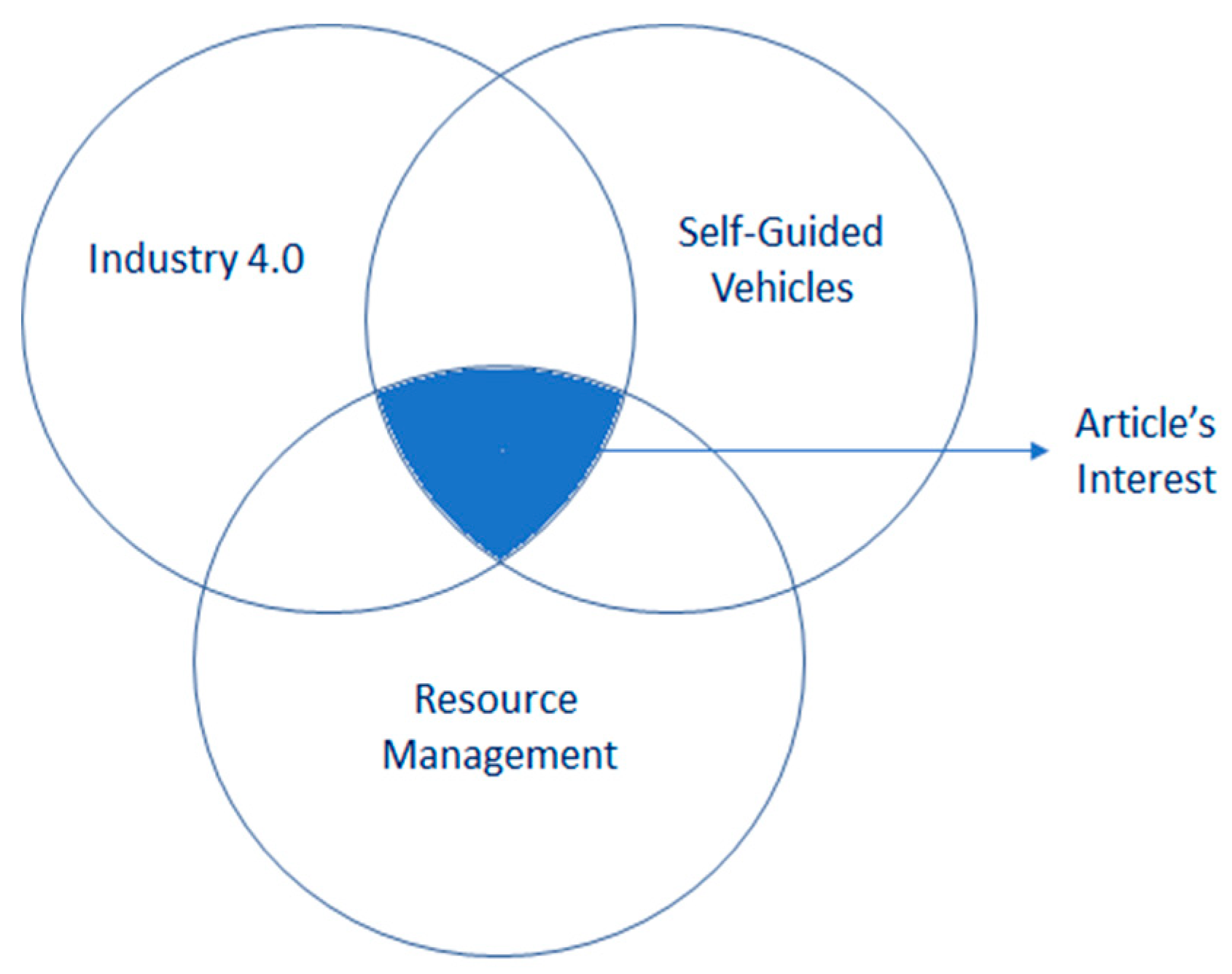
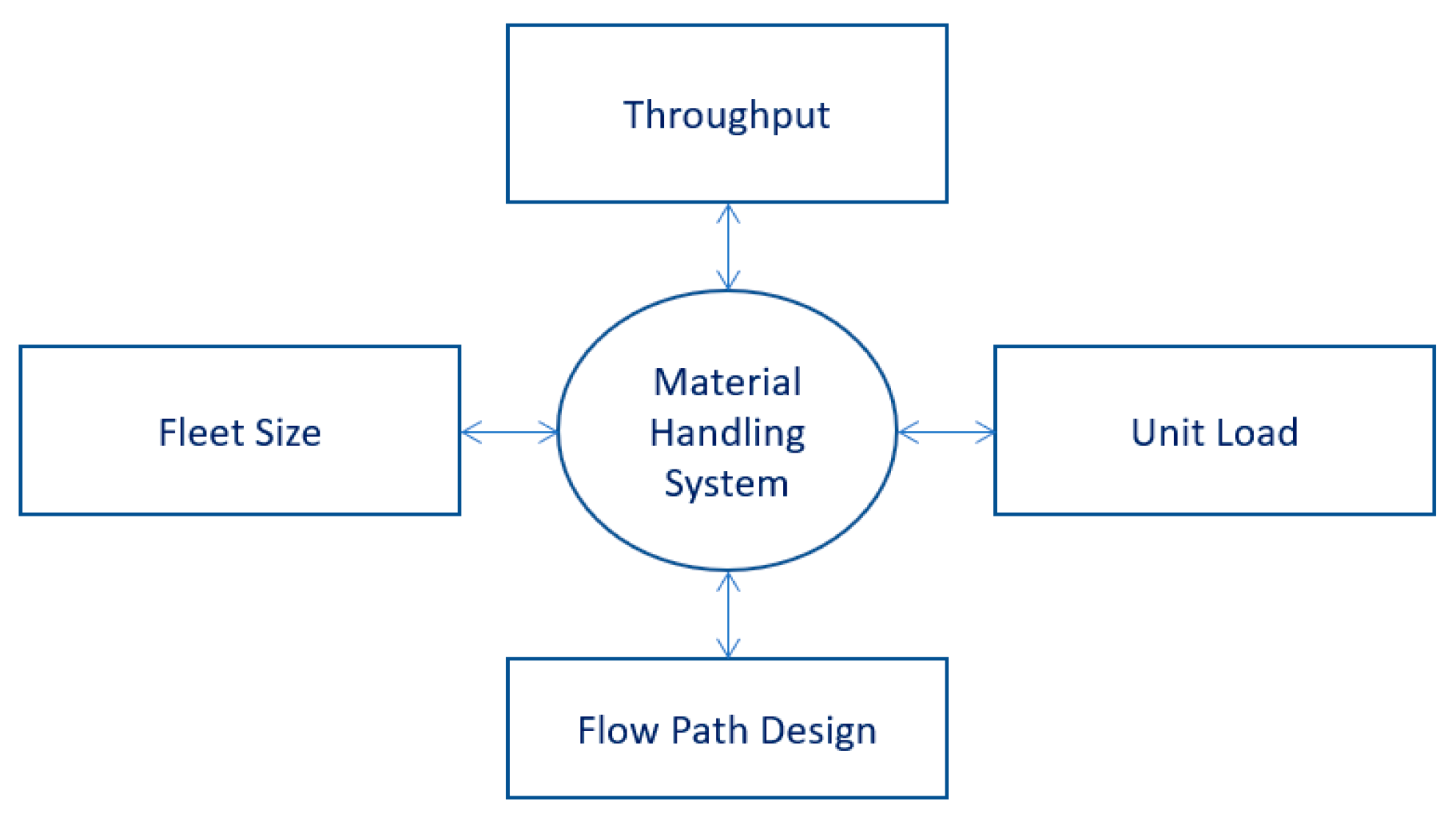
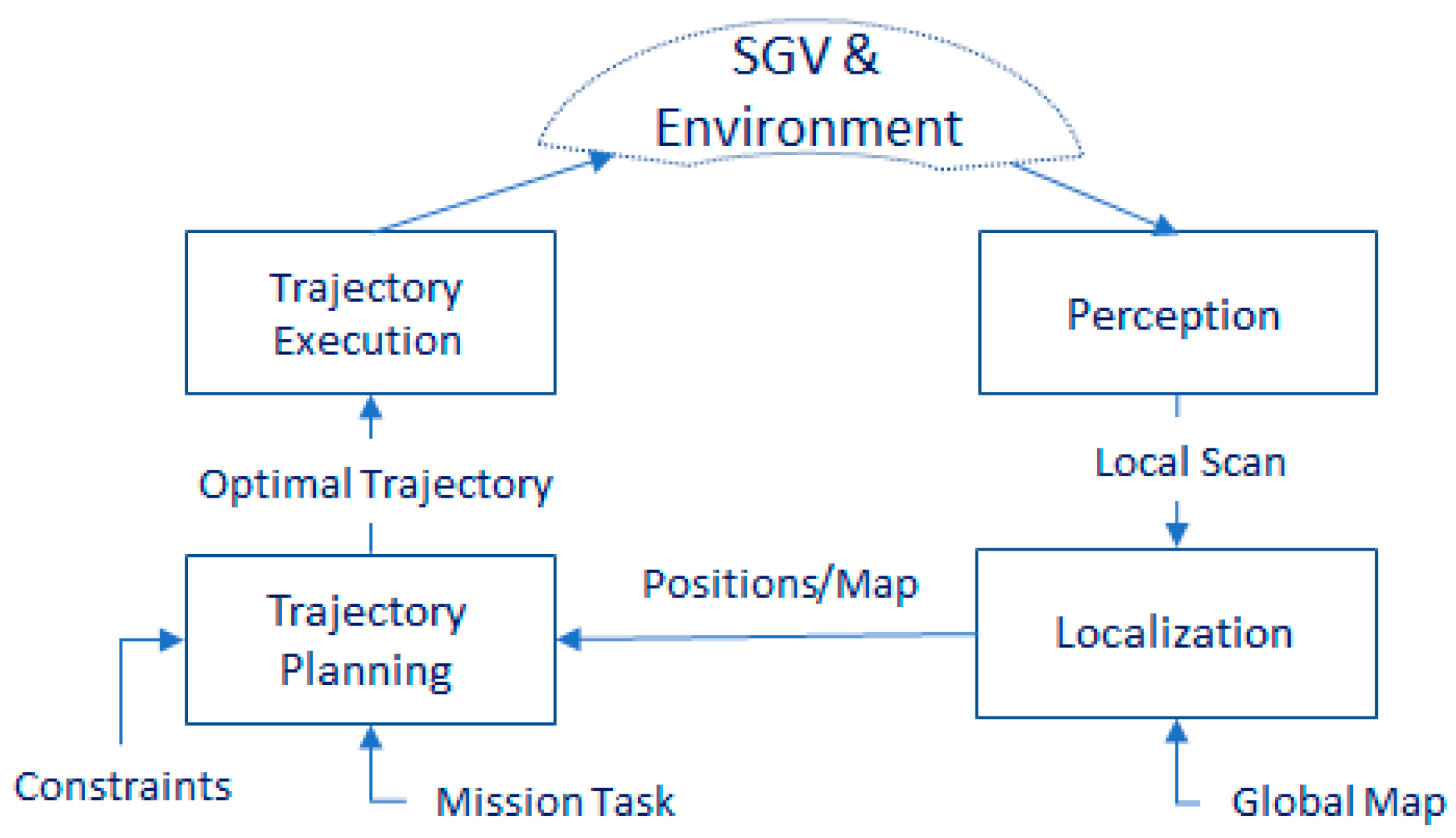
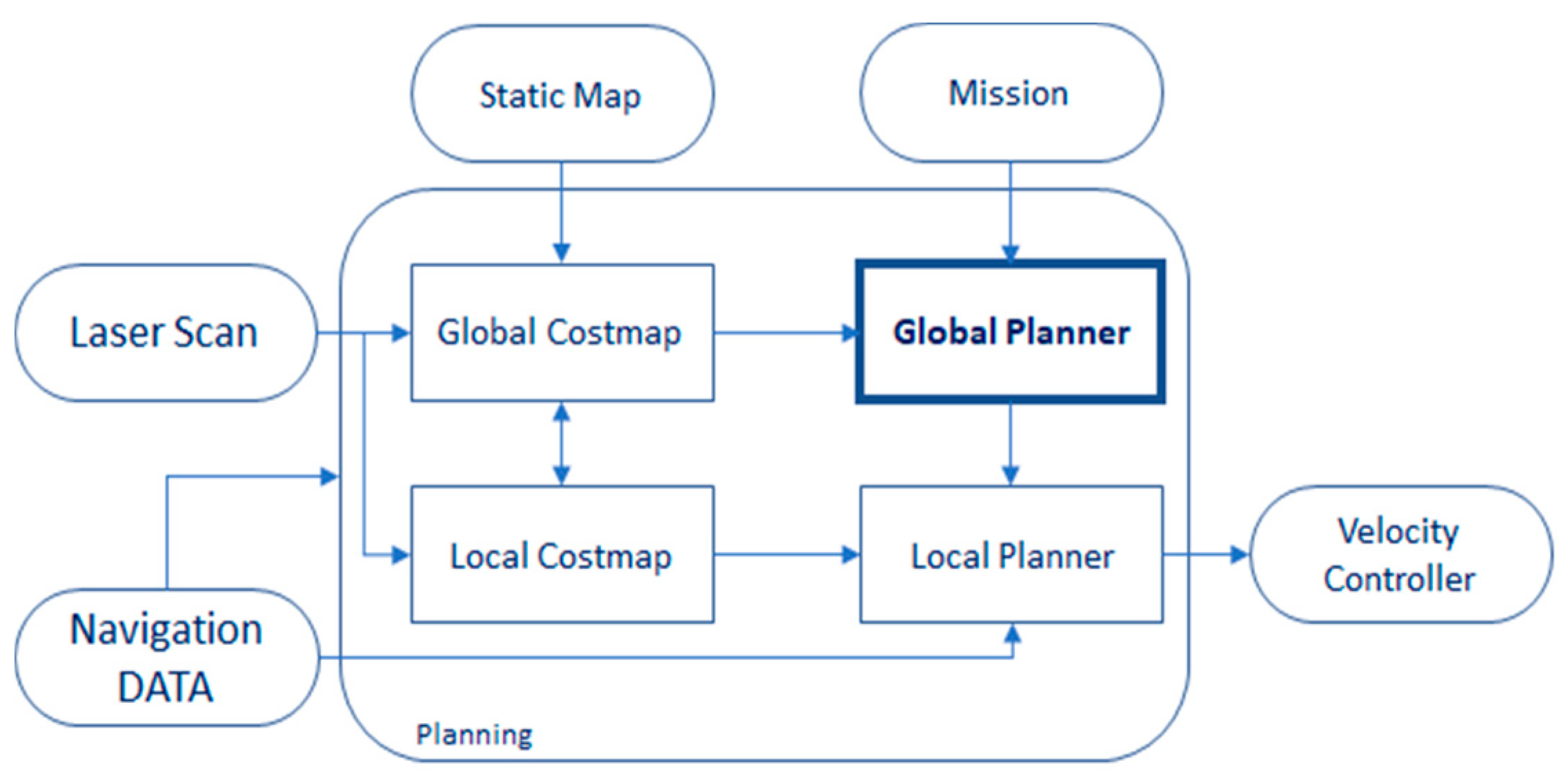
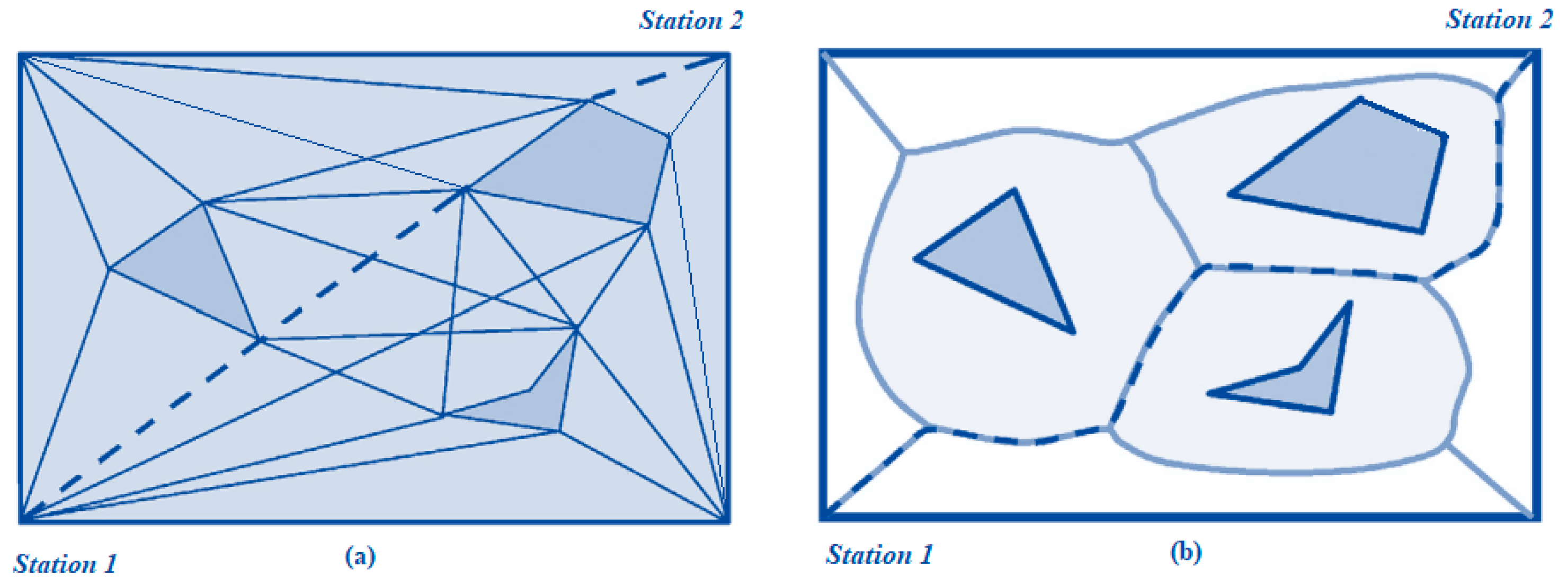
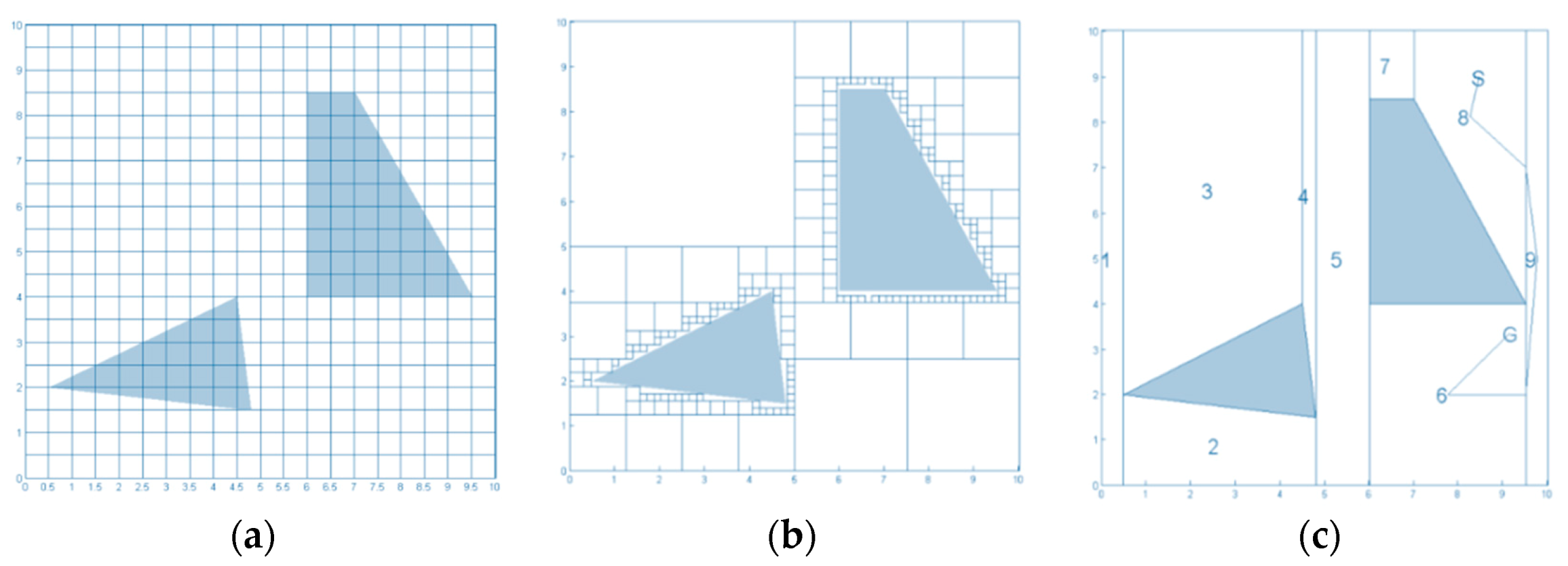

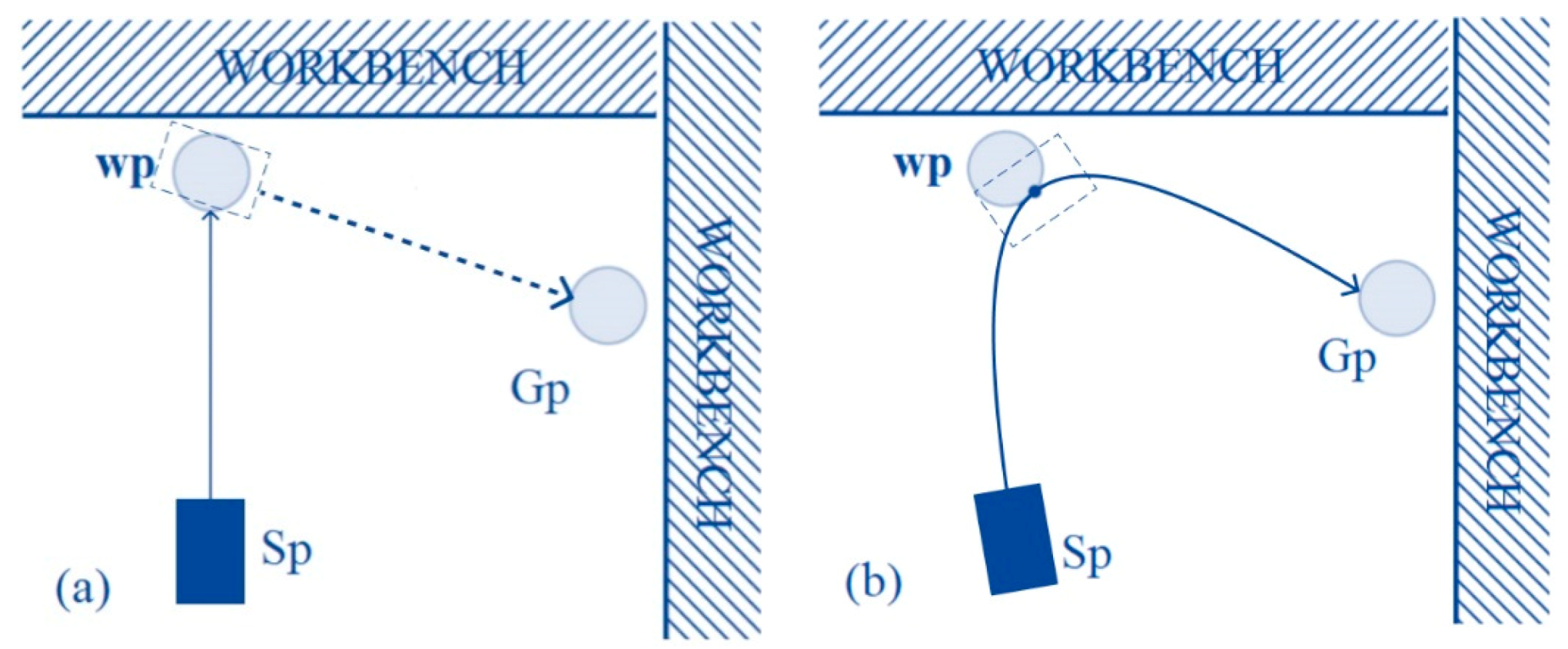

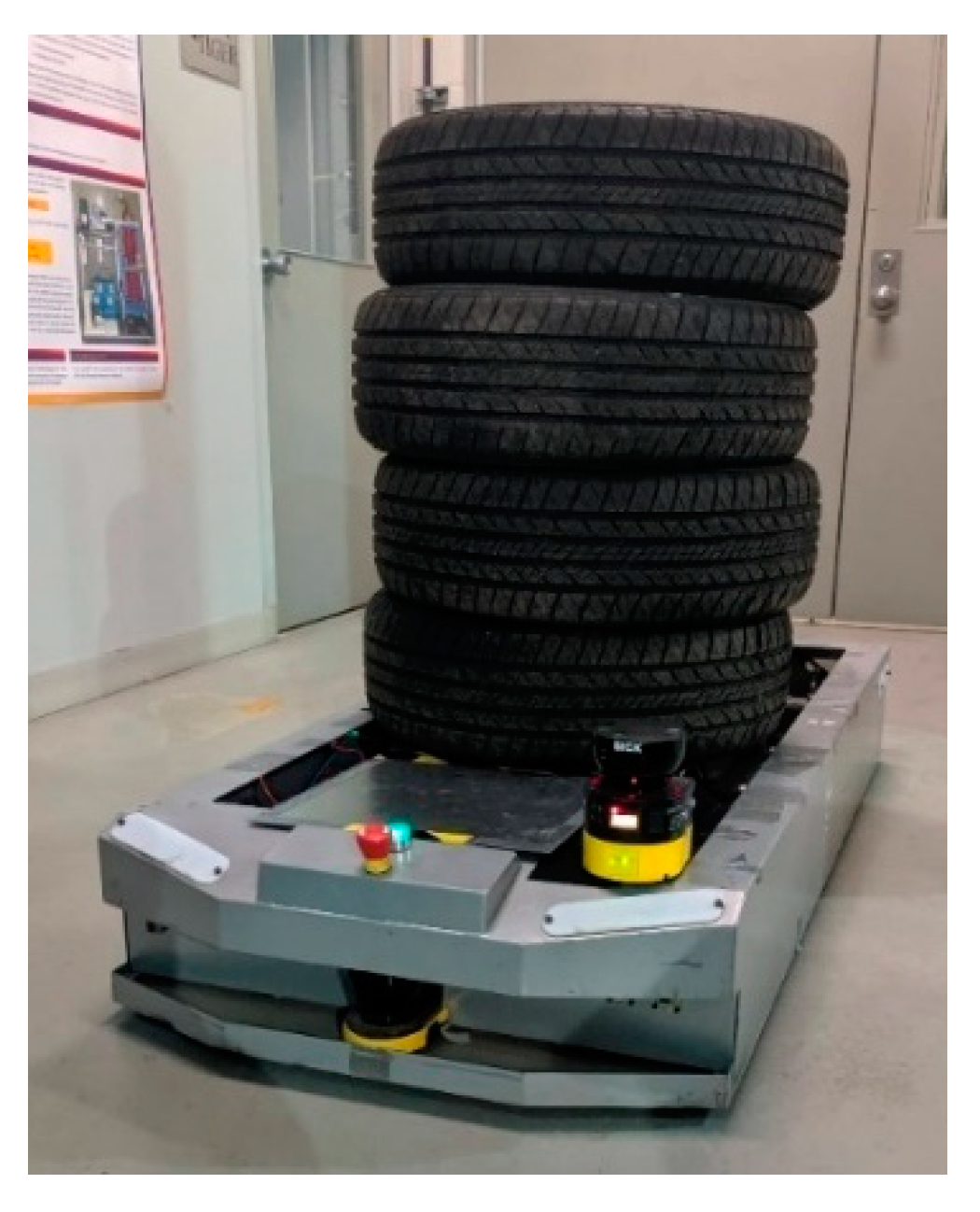
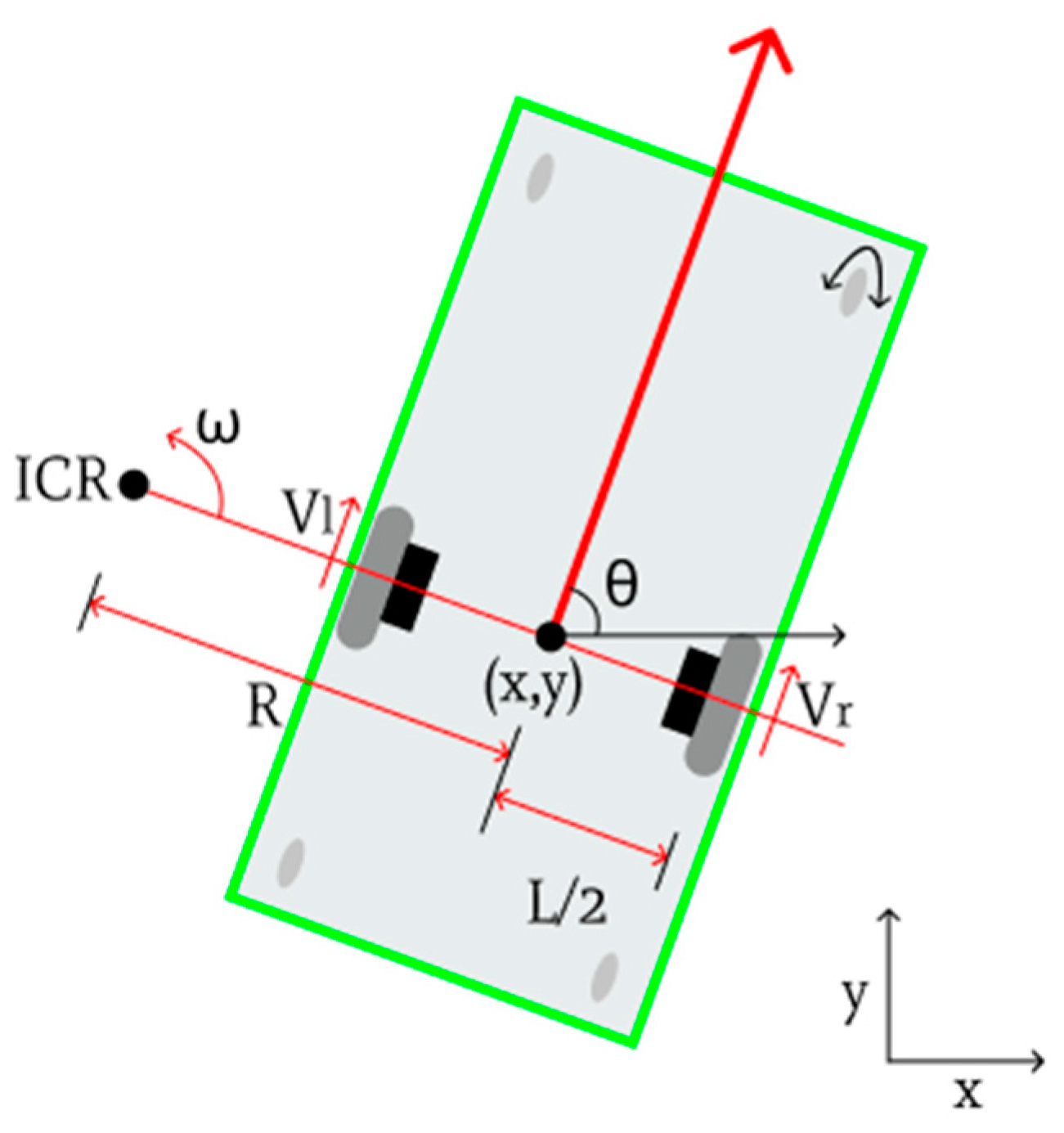
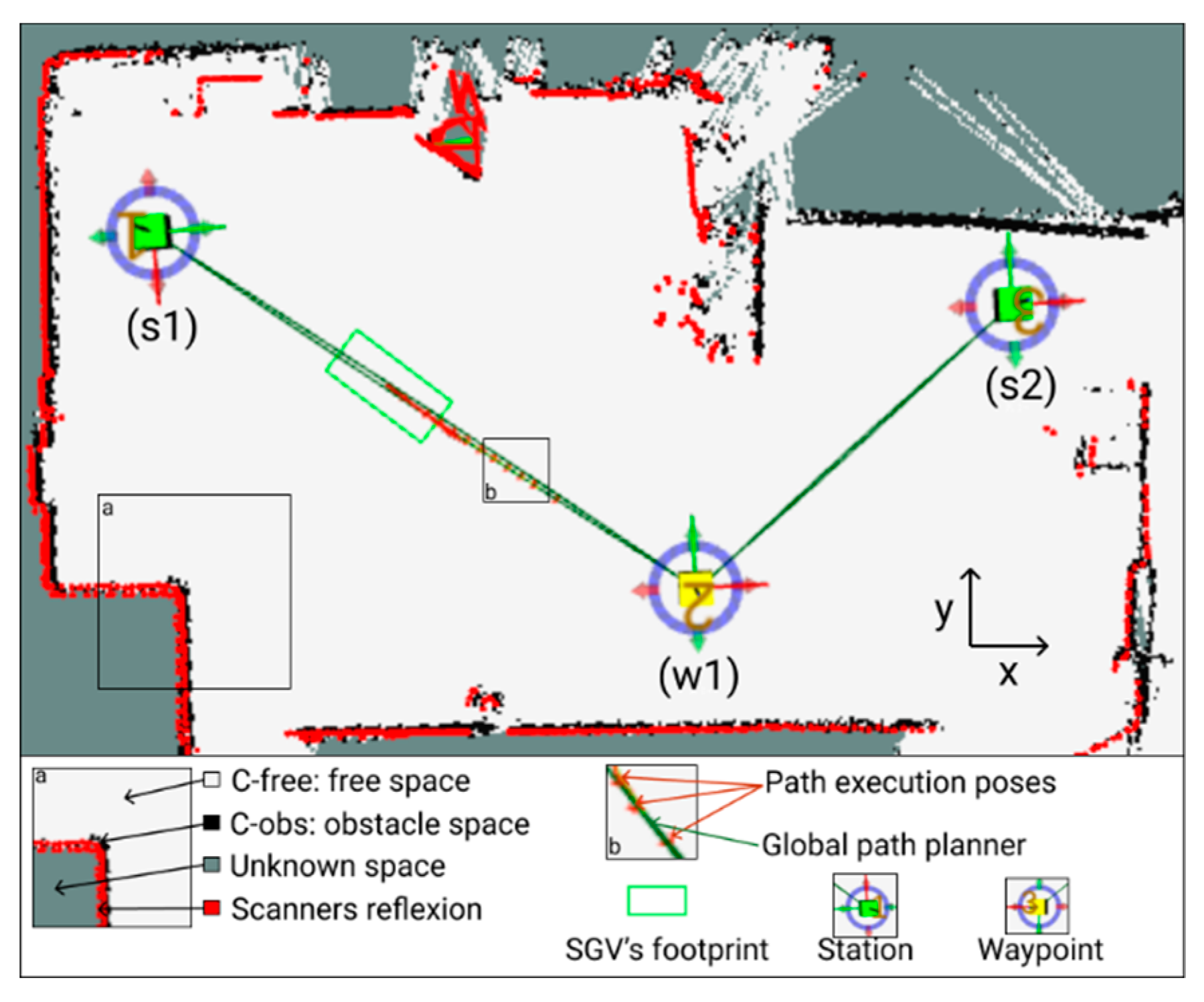
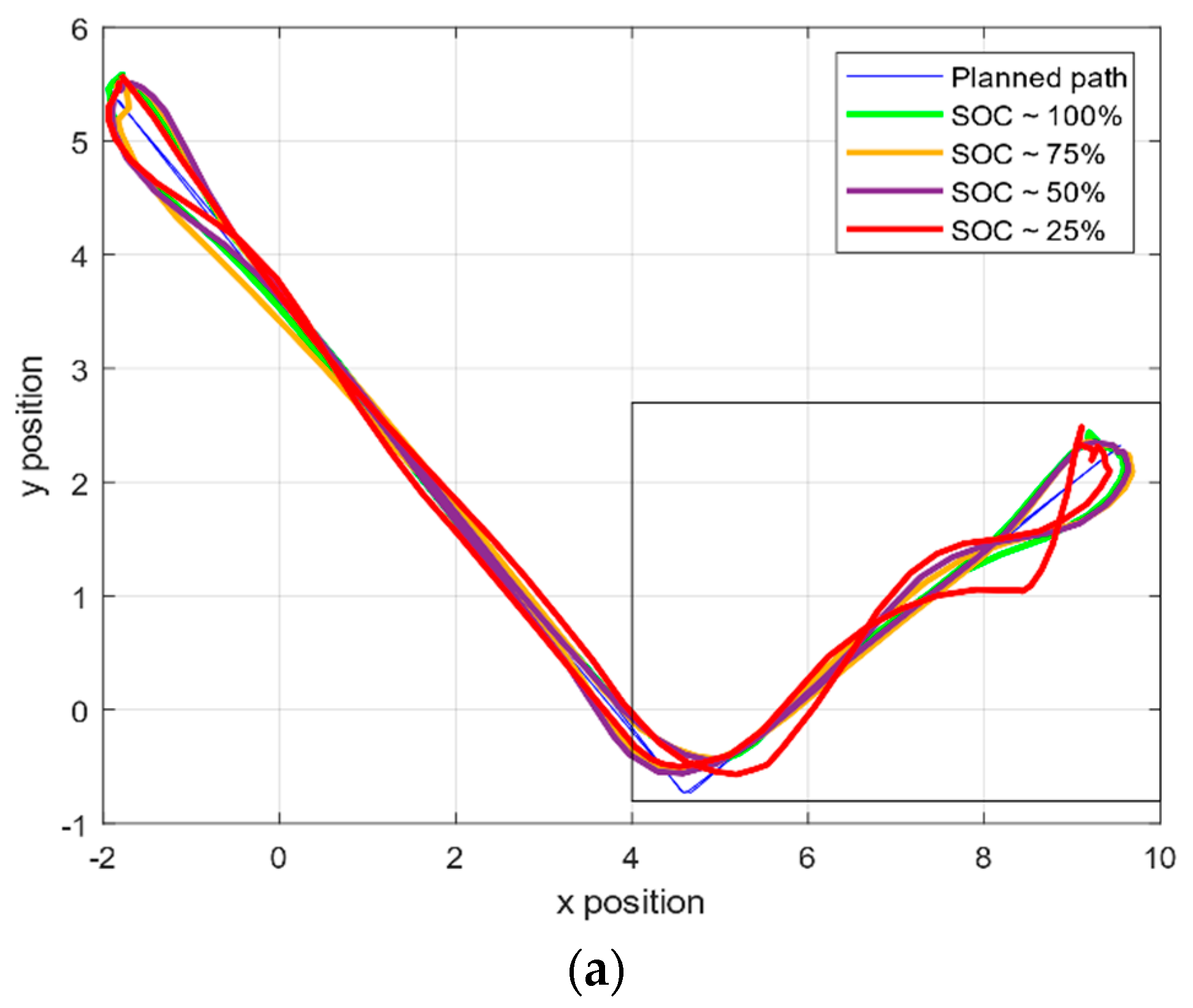
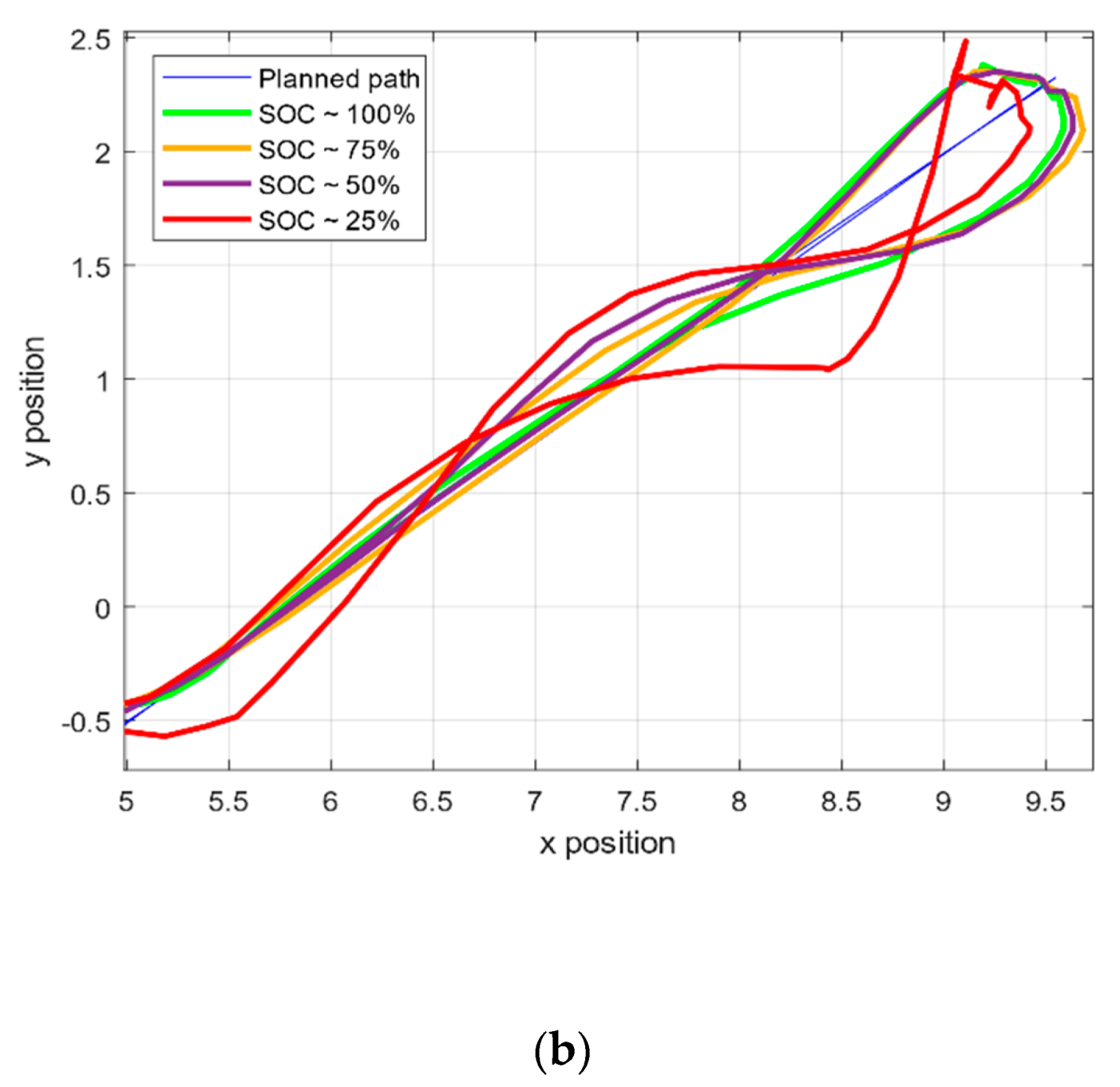
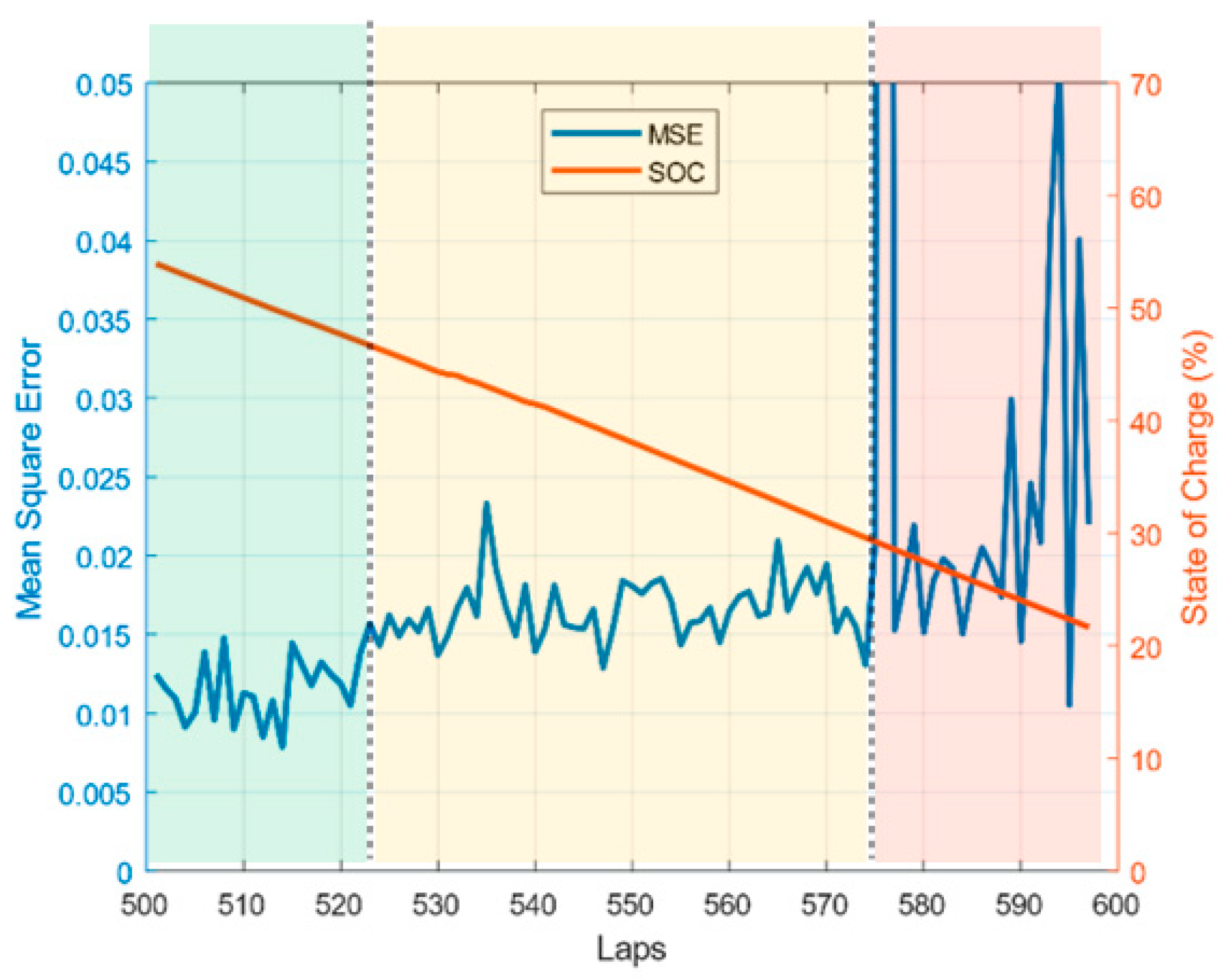
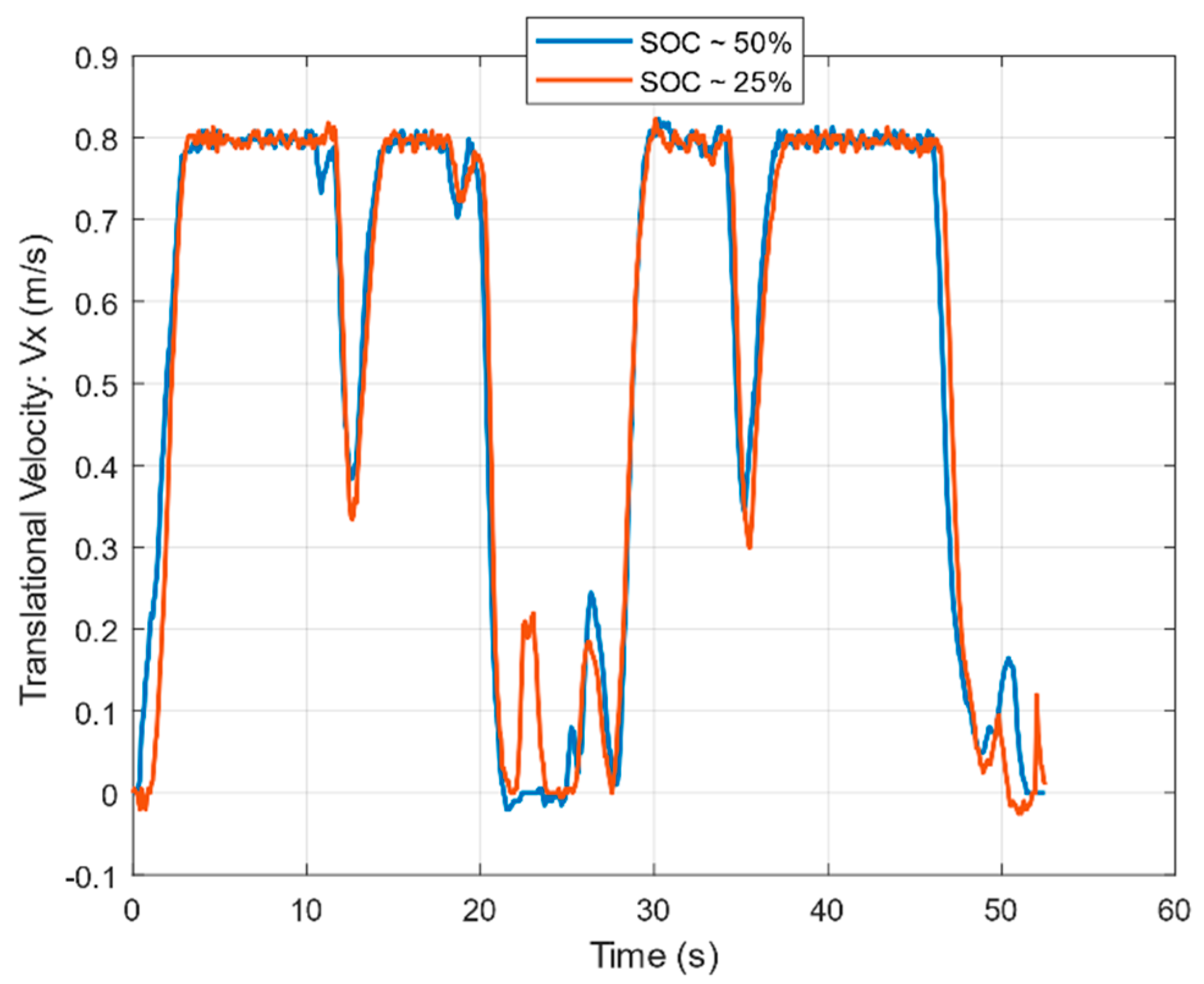
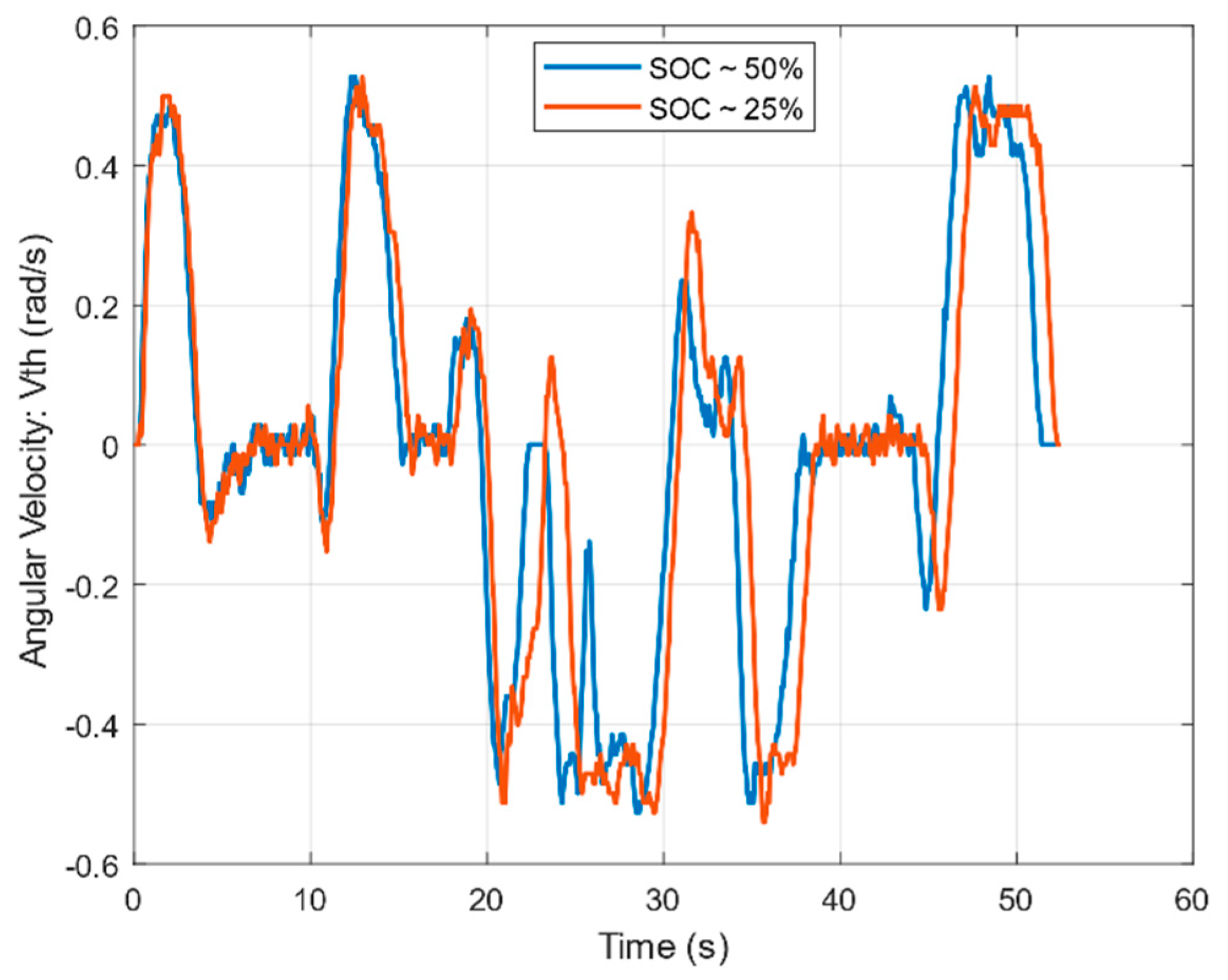
| System | AGV-System | SGV-System |
|---|---|---|
| System Architecture | Centralized | Decentralized |
| Global optimality | Suboptimality | |
| Simplistic guidelines | Complex navigation system | |
| Small scaled system | Large scaled system | |
| Central communication | Intervehicle communication | |
| Map representation | Topological-map: A series of a point route connecting different locations, no dynamic obstacles representation. | Pixel-map: a high-resolution occupancy grid. It uses configuration space for static obstacles representation in the environment, dynamic obstacles represented. |
| Localization | Basic physical localization sensors. | Advanced localization algorithms with sensor fusion of GPS, laser scan, vision-based. |
| Trajectory Planning | Uses: direct search algorithm, on a fixed flow path layout. Less flexible paths. | Uses: sample-based algorithm, search-based algorithms, graph search algorithm, replanning in case of deadlocks, constrained path such as time, energy, and distance. |
| Motion Execution | Not robust to dynamics. Line following motion. | Robust in dynamic situation with motion algorithms such, obstacle avoidance. |
| Sustainability | Less flexible to energy issues. | Flexible for solving resource management issues |
| Parameter | Value |
|---|---|
| Maximum Speed | 1.5 m/s (5 Km/h) |
| Vehicle Weight | 90 Kg |
| Maximum Load Carrying | 120 Kg |
| Battery Lifetime 1 | 7 h to 9 h |
| Dimensions (length × width × height) | 165 × 76 × 23 cm |
| Case Study | Maximum Velocities | Battery SOC | Total Energy ESGV (Joule) | Execution Time (Second) | Difference in Percentage | ||
|---|---|---|---|---|---|---|---|
| Vmax (m/s) | max (rad/s) | Energy | Time | ||||
| CS1 | 0.80 | 0.5 | SOC = 50% | 8064 | 51.3 | - | - |
| CS2 | 0.80 | 0.5 | SOC = 25% | 8388 | 52.5 | +4.0% | +2.3% |
| CS3 | 0.76 | 0.47 | SOC = 25% | 8132 | 53.6 | +0.8% | +4.5% |
Publisher’s Note: MDPI stays neutral with regard to jurisdictional claims in published maps and institutional affiliations. |
© 2020 by the authors. Licensee MDPI, Basel, Switzerland. This article is an open access article distributed under the terms and conditions of the Creative Commons Attribution (CC BY) license (http://creativecommons.org/licenses/by/4.0/).
Share and Cite
Graba, M.; Kelouwani, S.; Zeghmi, L.; Amamou, A.; Agbossou, K.; Mohammadpour, M. Investigating the Impact of Energy Source Level on the Self-Guided Vehicle System Performances, in the Industry 4.0 Context. Sustainability 2020, 12, 8541. https://doi.org/10.3390/su12208541
Graba M, Kelouwani S, Zeghmi L, Amamou A, Agbossou K, Mohammadpour M. Investigating the Impact of Energy Source Level on the Self-Guided Vehicle System Performances, in the Industry 4.0 Context. Sustainability. 2020; 12(20):8541. https://doi.org/10.3390/su12208541
Chicago/Turabian StyleGraba, Massinissa, Sousso Kelouwani, Lotfi Zeghmi, Ali Amamou, Kodjo Agbossou, and Mohammad Mohammadpour. 2020. "Investigating the Impact of Energy Source Level on the Self-Guided Vehicle System Performances, in the Industry 4.0 Context" Sustainability 12, no. 20: 8541. https://doi.org/10.3390/su12208541
APA StyleGraba, M., Kelouwani, S., Zeghmi, L., Amamou, A., Agbossou, K., & Mohammadpour, M. (2020). Investigating the Impact of Energy Source Level on the Self-Guided Vehicle System Performances, in the Industry 4.0 Context. Sustainability, 12(20), 8541. https://doi.org/10.3390/su12208541






